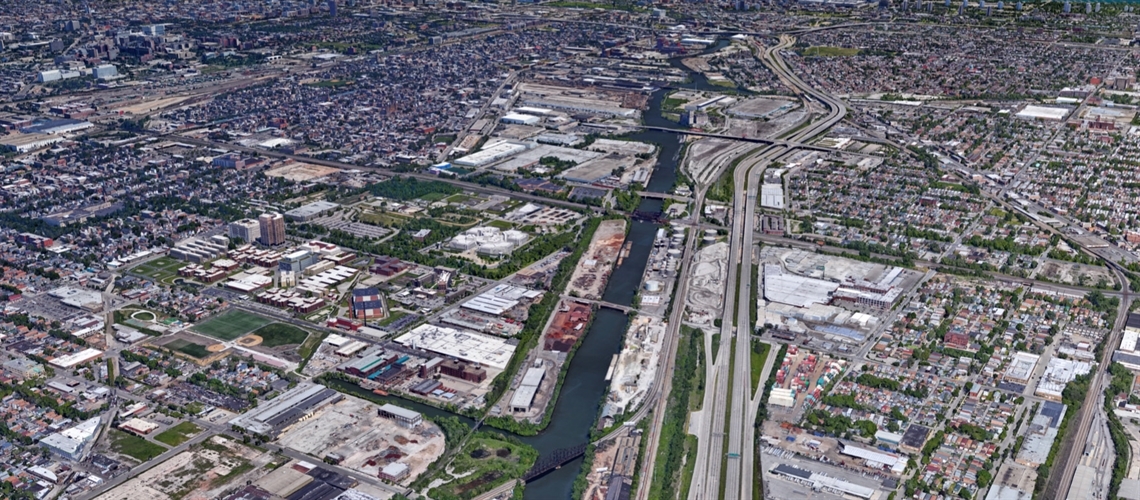Productive
2020 Goal: New visions for modern working rivers

Google
Industry in Pilsen and Little Village benefit from easy access to rail, interstate highways and a navigable river.
We will build upon the river as a recognized asset for both water-dependent businesses and employers who see the value of river adjacency for their workforce, commuting and corporate culture. In doing so, we’ll redefine what “industrial” means and how other land uses can occur within the same landscapes.
Each of Chicago’s five riverfront industrial corridors has unique pressures and assets, so we need five corridor-specific land use policies that attract an appropriate mix of productive enterprises and complementary uses. Redevelopment of riverfront land should account for and embrace proximity to the river. We will need to evaluate and address environmental impacts to ensure new uses are compatible with the living and inviting tenets of Our Great Rivers. Robust stakeholder engagement will lead to better riverfront land use planning and policies. Where traditional industrial uses have declined or relocated, the City should aggressively pursue redevelopment that balances neighborhood, city and regional goals for employment, parks and open space, environmental remediation and stormwater management. The result will be a stronger and more modernized industrial sector—one that may not even look like traditional perceptions of industry—and new economic growth or other uses where industry is no longer the most prudent use.
Redevelopment of dormant riverfront parcels outside of these corridors also will be aggressively encouraged. Legacy land uses for utilities, transportation and waste management will be scrutinized to determine the optimal siting of those facilities, as well as possible new uses for those sites.
Corridor-specific visions for riverfront Productivity Zones:
North Branch
The transit-rich North Branch Industrial Corridor can be a diversified employment hub for Chicago’s innovation economy. While long-time river-based industries continue to provide valuable services, new tech, craft, creative and collaborative business investments will create new jobs for highly skilled workers. In turn, nearby population growth will support new amenities, such as restaurants and bars, as well as infrastructure investment in bridges, riverfront parks and paths to provide an array of commuting options.
Pilsen
Located at the confluence of the South Branch of the Chicago River, Chicago Sanitary and Ship Canal and Bubbly Creek, the Pilsen Industrial Corridor supports a diverse mix of wholesale trade, manufacturing, transportation and distribution businesses. Large developable parcels and the corridor’s proximity to Chicago’s transportation network and central business district make it well-positioned for growth, including transit-oriented development and riverfront amenities. By redeveloping or remediating the river itself, Bubbly Creek, vacant riverfront parcels, blighted industrial sites and vacant buildings, we will generate new jobs and public access to the riverfront, where prudent.
Little Village
With excellent access to the I-55 corridor, active railroads and navigable waterways, the Little Village Industrial Corridor provides quality jobs in transportation, food production, warehousing and manufacturing. By rethinking the industrial corridor and embracing its access to the Chicago Sanitary and Ship Canal, Chicago will invigorate the local economy, correct harmful environmental conditions (e.g. dust, noise, contaminated sediments) and build local employment. Obsolete properties provide opportunities for transition to modern uses through property assembly and environmental remediation. Multiple riverfront parcels—many with spectacular views—will become new neighborhood and regional destinations.
Calumet
The Calumet River is a key freight connection between Lake Michigan and the rest of the Chicago Area Waterway System. The Calumet Industrial Corridor will become a renowned national model for the co-existence of productive and sustainable industry, thriving communities and healthy natural areas. To do so, the region must work to attract more job-rich manufacturers that rely on the waterways and barge shipping, while encouraging industrial stakeholders to proactively mitigate negative impacts on the environment and public health.
Addison
Along the Chicago River’s North Branch, traversing portions of the North Center, Avondale and Logan Square neighborhoods, the Addison Industrial Corridor is a 21st Century urban business park with excellent access to transit and skilled workers. Redeveloping properties to create appropriate commercial and mixed-use developments will draw businesses that want to tap into the creative economy. Because companies located in the corridor do not use the waterway for operation, the area can create new riverfront access and recreation and strengthen connections to neighborhood amenities like the riverfront trail and Clark Park.
Making it happen
Conduct a broad and robust public engagement process to develop land use plans and policies that balance community desires, ecosystem health of the rivers and riverfronts, the needs of modern industry, and other productive uses.
Pursue policy changes and infrastructure projects consistent with these new land use plans. This may include rezoning, developing new incentive programs, updating environmental and health codes, improving streets and bridges, and more.
Key players
Chicago Dept. of Planning and Development, Chicago Dept. of Transportation, Chicago and Illinois chambers of commerce, area industrial councils and business associations, neighborhood organizations
Our rivers, our role
- Participate in the Chicago Dept. of Planning and Development’s forthcoming Industrial Land Use Corridor public engagement processes.
- Organize a neighborhood tour of legacy and new industrial uses along the riverfront to learn more about the needs of these businesses and opportunities for integration with other community and ecological interests. Many business owners eagerly host tours of this kind, but are rarely approached.
Back to goals